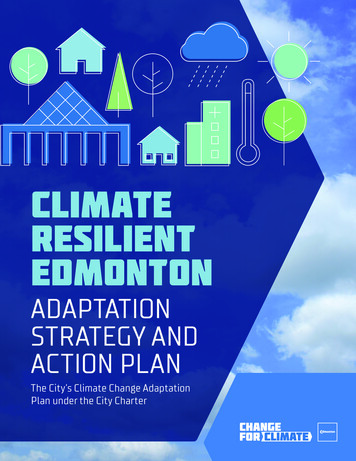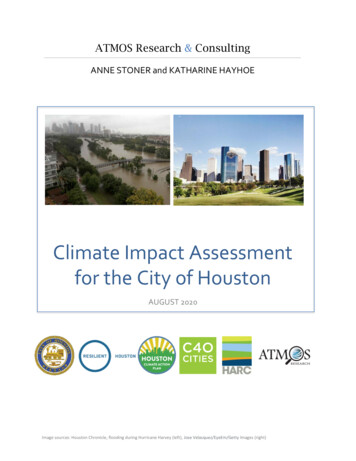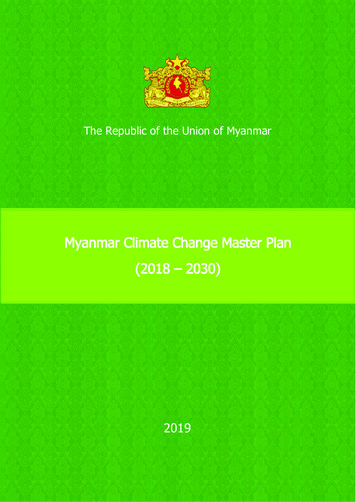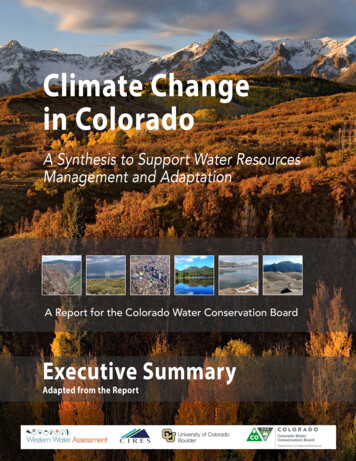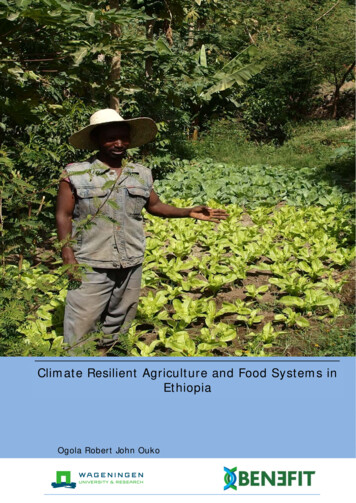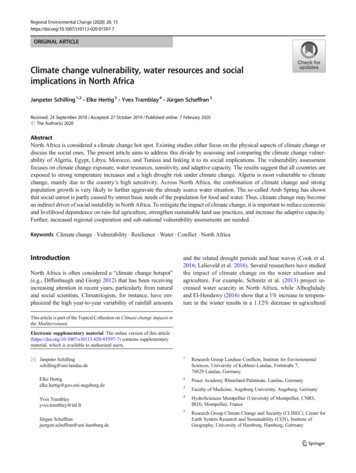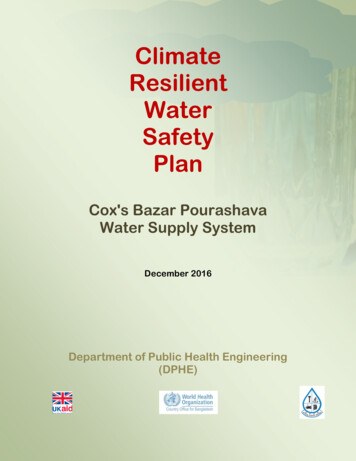
Transcription
ClimateResilientWaterSafetyPlanCox's Bazar PourashavaWater Supply SystemDecember 2016Department of Public Health Engineering(DPHE)
ContentsLIST OF FIGURES . 3LIST OF TABLES . 41. INTRODUCTION . 52. WATER SAFETY PLAN (WSP) TEAM. 62.1 Cox's Bazar Pourashava WSP Team. 62.1.1 WSP Team Objective . 62.1.2 Roles and Responsibilities of WSP Team . 72.1.3 Engagement of Stakeholders . 83. DESCRIPTION OF COX'S BAZAR POURASHAVA WATER SUPPLY SYSTEM . 93.1 Description of Water Supply System . 93.2 Water Quality of Cox's Bazar Pourashava Piped Water Supply System . 104. HAZARDOUS EVENT AND RISK ANALYSIS . 124.1 Identification of Hazards Associated with Water Supply System . 124.1.1 Indetified Environmental Hazards . 124.1.2 Identification of Climatic hazards . 134.2 Assessment of Risk . 134.3 Development of the Hazard Matrix . 144.4 Determination and Validation of Control Measures . 144.5 Reassessment of the Risks . 155. IMPROVEMENT ACTION PLAN . 196. OPERATIONAL MONITORING AND CORRECTIVE ACTIONS . 217. VERIFICATION PROCEDURE . 258. MANAGEMENT PROCEDURES . 268.1 Management Procedure . 268.2 Control of Document and Records . 268.3 Communicating Procedure of Water Quality Related Information . 279. SUPPORTING PROGRAMS . 2810. WSP REVIEW PROCEDURE . 2910.1 Purpose of WSP Review . 2910.2 Review Procedure and Elements . 2910.3 WSP Document Up-gradation . 29ANNEX - 1: OPERATIONAL MONITORING LOG SHEET . 30Annex 1.1: Log Sheet for System Maintenance. 30Annex 1.2: Log Sheet for Water Quality Monitoring . 31Annex 1.3: Complaint Register Book. 32Annex 1.4: Disease Information Register . 33Annex 1.5: Water Table Recording Register . 34Annex 1.6: Log Sheet for Pump Operation Record. 35Annex 1.7: Household Practice Record Register Book . 36ANNEX - 2: IMAGES . 37
List of FiguresFigure 1: Flow diagram of Cox's Bazar Pourashava Water Supply System. 9Figure 2: Opening ceremony of hazard analysis workshop in Cox's Bazar Pourashava. 37Figure 3: Group work during hazard analysis workshop. 37
List of TablesTable 1: List of members of Cox's Bazar Pourashava WSP team . 6Table 2: Roles and responsibilities of members of climate resilient WSP team . 7Table 3: Different information on the Cox's Bazar Pourashava piped water supply system . 9Table 4: Analysis result of different water quality parameters at source . 10Table 5: Water quality test results for samples collected from user points in Cox's Bazar Pourashava . 10Table 6: Definition & score of "likelihood" and "severity" in risk analysis . 14Table 7: Risk Score & Ranking . 14Table 8: Hazard matrix for Cox's Bazar Pourashava water supply system . 16Table 9: Improvement action plan of Cox's Bazar Pourashava water supply system . 19Table 10: Operational monitoring plan of Cox's Bazar Pourashava water supply system . 21Table 11: Verification schedule of water safety plan for Cox's Bazar Pourashava . 25Table 12: Management procedures for related documents . 26Table 13: Communication plan for water quality related issues . 27Table 14: List of Supporting Program for WSP of Cox's Bazar Pourashava . 28
1. IntroductionThe comprehensive risk assessment and management approach from source to consumer is most effectivemeans of consistently ensuring the drinking water safety termed as water safety plan (WSP). The climateresilient water safety plan considered the climatic hazards more rigorously along with the environmentalhazards. The climatic variability, climate extreme events and environmental problems (water salinity) hasbeen deteriorating the physical, chemical and biological quality of supply water as well as the wateravailability. As a result the incidences of water born/washed/related diseases such as diarrhoea, cholera,dysentery, skin diseases, jaundice, hepatitis and vector born disease like malaria, dengue, etc., areincreasing significantly in Bangladesh. In addition, climatic and environmental hazards can have impactat different steps of a water supply system, e.g., source/catchment, treatment plant, storage, distributionand household connections of the piped line water supply system. The extreme climate events have beendeteriorating the water quality chemically and biologically, and affecting availability of fresh water,which are leaving the people to a vulnerable situation.The Cox's Bazar Pourashava is situated by the side of the Bay of Bengal. The primary climatic parametersnamely temperature, rainfall, humidity along with the climate extreme events like sea level rise, storms,tidal surges were found as major threats in this area as far as water supply system is concerned. Todevelop a climate resilient WSP for this Pourashava, a team was formed by involving the Pourashavawater professionals, Professionals from Department of Public Health Engineering, BangladeshMeteorological Department etc. The team developed the climate resilient water safety plan forPourashava water supply system in collaboration with DPHE with the technical assistance of PMID andWHO. Implementation of the climate resilient water safety plan will eventually reduce the risk of waterborne diseases by improving the quality of water. The increase of temperature, humidity and rainfall,cyclone and tidal surges were the major climatic threats found in Cox's Bazar Pourashava which candeteriorate the water quality and safety. The increase of temperature would affect the water quality andavailability, and hence health of Pourashava dwellers. Inadequate solid waste management, poor drainagefacility, lack of fecal sludge management services, salinity and arsenic problem in ground water were themajor environmental concerns for the water supply system. The water table goes down during the summerseason (March to May) in this area too, which causes scarcity of water. Together with changedtemperature, depletion of water table during dry season, salinity in groundwater, cyclones and tidalsurges, Cox's Bazar Pourashava dwellers have become more vulnerable considering its health impact.The climate resilient WSP document for Cox's Bazar Pourashava was aimed at developing an operationalmonitoring plan as well as verification monitoring plan to facilitate effective implementation of WSP atfield level. The supporting programs needed to implement the plans have also been identified andcompiled in this document. In this climate resilient WSP document, some samples of monitoring logsheets for staff of the Pourashava Water Supply Section (PWSS) are provided that would help to keeprecord of different information in relation to the climate resilient WSP implementation in Cox's BazarPourashava. It is expected that this WSP document for Cox's Bazar Pourashava will be utilized inprioritizing interventions that are needed to improve the water supply system and to gain confidence ofusers on the Water Supply System. The systematic approach suggested in the WSP would help PWSSstaff to gradually overcome the limitations that often drive them to compromise with water quality.
2. Water Safety Plan (WSP) Team2.1 Cox's Bazar Pourashava WSP TeamThe authority of Cox's Bazar Pourashava under Cox's Bazar district is committed to engage relevant staffof Pourashava Council and other stakeholders to implement "Climate Resilient Water Safety Plan" forCox's Bazar Pourashava and to provide continuous support. In this respect, a statement of suchcommitment was signed by the top authority, and circulated as declaration. The statement will beincluded in the citizen charter of the Pourashava. In order to implementing the Climate Resilient WSP, theMayor of Cox's Bazar Pourashava assembled a Climate Resilient WSP team in consultation with DPHE.The Climate Resilient WSP team will be responsible for developing, implementing and maintaining theWSP. The team is presented in Table 1.Table 1: List of members of Cox's Bazar Pourashava WSP teamNo. NameAffiliation /Job TitleRole in WSP teamContact Information(Phone no.)1Md. Mahbubur Rahman Chowdhury Mayor, Cox's Bazar Pourashava01741-1330602Md. Nurul AlamChairmanGeneralExecutive Engineer (Pourashava)Secretary01688-5591513Anupom DeyExecutive Engineer (DPHE)Member01554-3165024Mir Md. Sirajul Kalam AzadAssistant EngineerMember01819-5361895Ranjit Kumar DeyWater SuperMember01710-4186696Ashraful Huda Siddiki JamshedCouncillorMember01819-1029847Civil SurgeonRepresentative of Cox'sDevelopment AuthorityZahed Sarwar SohelCivil SurgeonMember0341-63768Cox's Development 32390Sub. Asst. Engineer (DPHE)Head Master, Cox's Govt. GirlsHigh SchoolBangladesh Awami League,Cox's BazarBMD Station, Cox's 84-840001Member0341-636188910 Deepshikha Chakma11 Md. Nasir Uddin12 Local Representative13 Meteorologist2.1.1 WSP Team ObjectiveThe members of climate resilient WSP team of Cox's Bazar Pourashava will operate to accomplish thefollowing objectives: Supporting all activities aimed at ensuring supply of safe water to all consumers. Maintaining the Pourashava supply water considering environmental and climatic concerns regularly. Capacity building of all officers, staff and workers of Water Supply Section (PWSS) of the Pourashavathrough training.
Awareness rising among the consumers about the importance of "safe water" and "safe use of water"through courtyard meetings. Regular monitoring of quality of the supplied water at source and at consumers' end. Encouraging all consumers to pay water bill regularly. Ensuring proper implementation of climate resilient WSP in Cox's Bazar Pourashava and support allPWSS staff to implement each step of the documented WSP. Maintaining update of the log books, e.g., maintenance of the system, water quality monitoring andcomplaint log books.2.1.2 Roles and Responsibilities of WSP TeamIt is helpful if the responsibilities of each WSP member are clearly defined during formation of theclimate resilient WSP team so that it becomes clear who will do what and when. The team includespeople with authority to make any required changes easy, as well as those with technical ability todevelop climate resilient WSP and supervise the implementation. For successful implementation of theclimate resilient WSP, the major tasks of the Team can be outlined as follows:1. Regular checking of the progress on improvement plan.2. Regular checking and reviewing different log books if the assigned professionals/workers arepreserving different types of data and information3. Regular checking of operational monitoring works.4. Regular checking of WSP application and its functional integrity in different steps.5. Preparation and checking of annual report on climate resilient WSP and impact of WSP on watersupply system.6. Facilitating implementation of the decisions taken by climate resilient WSP team in meetings.7. Monitoring actions taken by Pourashava Water Supply Section to implement WSP.8. Facilitation of awareness raising program for consumers on safe water.9. Encouraging all consumers to pay water bill regularly.10. Increasing number of water connections by campaigning.11. Participating in review of climate resilient WSP each year.12. Maintaining all log books.The individual roles and responsibilities of the WSP Team members are described below in Table 2.Table 2: Roles and responsibilities of members of climate resilient WSP teamTeam MembersRoles & Responsibility Chairman Sign letters and documents relevant to climate resilient WSP, supervise the implementationChair the regular climate resilient WSP team meetingMake necessary recommendations to implement the decisions taken climate resilient WSPteamTake required steps to ensure financial support to implement WSPDistribute responsibilities among the climate resilient WSP team members and supervisetheir progress activities
Team MembersRoles & Responsibility Ensure review of climate resilient WSP document Maintain communication with climate resilient WSP team Adviser & members, and sharingof relevant informationKeep record of all climate resilient WSP documents, meeting minutes, training events, plansetc.Check climate resilient WSP monitoring log books regularlyMonitor quality of supplied water at regular intervalVerification of climate resilient WSP implementation through sanitary inspectionDevelop emergency plans and prepare PWSS staff for emergency situationsTake necessary steps to review and update climate resilient WSP each year MemberSecretary Member Carry out the tasks related to climate resilient WSP assigned by Chairman and Adviser ofclimate resilient WSP teamCommunicate regularly with all relevant stakeholdersCommunicate regularly with the Surveillance committeeAssist staff to collect data related about the user satisfactionHelp PWSS to take necessary steps during emergency situationsProvide necessary support to PWSS to ensure a successful implementation of climateresilientParticipate all climate resilient WSP meetings, trainings and review workshops2.1.3 Engagement of StakeholdersDepartment of Public Health Engineering (DPHE) is considered as the main stakeholder of the Cox'sBazar Pourashava piped water supply system. DPHE professionals have advisory roles to provide all sortsof technical supports for the implementation of climate resilient WSP. In addition, the Executive Engineer,DPHE, Cox's Bazar, will coordinate participation of different stakeholders and national surveillancecommittee to implement the developed climate resilient WSP in the Cox's Bazar Pourashava Water SupplySystem.
3. Description of Cox's Bazar Pourashava Water Supply System3.1 Description of Water Supply SystemThe Pourashava piped water supply system of Cox's Bazar Pourashava was established in 1962. It usedthe groundwater as the source water. Groundwater was extracted by using eight production tube wellsthrough submersible pumps from boreholes. The depth at which the submersible pumps extract watervaried from 200'-555'. The average daily production of water was 2,400 m3/day. During the summerseasons (March to May), production of water was less due to water table depletion. Water was suppliedfor approximately 10-11 hours every day to the consumers. The water supply system in Cox's BazarPourashava did not have any treatment system and water was supplied to consumers through directpumping. The flow diagram of the water supply system of Cox's Bazar Pourashava is shown in Figure 1.Cox’s Bazar Pourashava Water Supply SystemDistribution Lines(Household/CommercialConnections and StreetWater Post)Source(Groundwater)Production Tube Well(Eight units)(Pump and PumpHouse)TransmissionLinesFigure 1: Flow diagram of Cox's Bazar Pourashava Water Supply SystemThe total number of connections in Cox's Bazar Pourashava water supply system was 996. ThePourashava consists of twelve wards and five of these twelve wards had piped water supply. The keyinformation about the water supply system of Cox's Bazar Pourashava is summarized in Table 3 below.Table 3: Different information on the Cox's Bazar Pourashava piped water supply systemStepSource of WaterDescriptionCurrent sourceGround waterTotal number of production tube well (PTW)11 (active 8; inactive 3)Average depth200-455 ftAbstraction processSubmersible pumpWater TreatmentProcessNo treatment system.ReservoirsNo reservoirs.
StepDescriptionDistribution LineTotal length of pipe line : 28.37 Km (diameter: 10"8"/6"/4";Household connection diameter: 1"/0.75"/0.5")Distribution time10-13 hours / dayIntended useThe distributed water is used for cooking, personal hygiene and household washing purposes.Only around 20% people drink water from this source.No. of SluiceValves23, out of which only three are active.No. of Wash OutChambersNo wash out valve was found in the system.3.2 Water Quality of Cox's Bazar Pourashava Piped Water Supply SystemSource water sample was collected from the production well and analysed for arsenic, iron, manganeseand E. coli. A total of seven samples were collected in this regard from seven production tube wells. Theresults are presented in Table 4. It is evident from the table that the risk for arsenic contamination was lowand below Bangladesh standard (0.05 mg/l), and the iron and manganese concentration was also belowthe Bangladesh standard. The risk of microbiological contamination was found intermediate in twosamples from two production tube wells and low in other five production tube wells of the source water.Table 4: Analysis result of different water quality parameters at sourceDate ofTestingLocationMicrobial Risk ElectricalChemical RiskE Coli/ 100AsFeMn(based on E Coli Conductivity(based on Asml(mg/l) (mg/l) 60low387 MDL0.15 MDLlowPump House-5 new (ward#10) 16.8.20160low507 MDL0.35 MDLlowPump House-5 old (ward#10)16.8.20160low7440.0140.1 MDLlowPump House-6 (ward#10)16.8.20160low8630.0020.3 MDLlowPump House-3 (ward#9)16.8.20160low12140.0040.15 MDLlowPump House-8 (ward#10)16.8.20167intermediate6720.0220.3 MDLlowPump House-2 (ward#9)16.8.20167intermediate1080 MDL0.3 MDLlowPump House-4 (ward#11)A total of 15 water samples were collected from the pipeline of the water supply system at different user shouse in five different wards where piped water supply was available. The water quality test wasperformed for fecal contamination. The results are presented in Table 5. The table indicated that the fecalcontamination of the supplied water in ward 3, 8 and 11 were found very high.Table 5: Water quality test results for samples collected from user points in Cox's Bazar PourashavaSl. No. Ward NoName of the UserE Coli/100 mlMicrobial Risk (basedon E Coliconcentration)111District Food Office3intermediate211Saikat Bagan Bari0low311Adv. Habibur Rahman240very high410Saidul Haq Azad0low
Sl. No. Ward NoName of the UserE Coli/100 mlMicrobial Risk (basedon E Coliconcentration)510Prof. G M Shafi0low610President, Dist Press Club0low73Shahpir Residential Hotel0low83Gulshan Ara Begum480very high93Adv. Md Bokhtiar320very high108Bakhtiar Kamal Chwd49high118Machang52high128Ongchola520very high139Onubroto Dhar4intermediate149General Hospital3intermediate159Dulal Das0lowAmong the 15 samples tested in five wards in Cox's Bazar Pourashava, 27% of the samples were foundhaving "very high" ( 99 CFU/100 ml) concentration of E. Coli. Apart from that, 13% of the sampleswere found within "high" (10-99 CFU/100 ml) concentration category, 20% within "intermediate" (1-9CFU/100 ml) category and 40% in "low" (0 CFU/100 ml) category. The result indicates incidences ofcontamination of supplied water in the pipe lines in few areas of the water supply system, which might bethe result of leakages in pipe lines/sluice valve chambers that causes intrusion of contaminated waterwhen the pressure of water is low in the pipe lines or during the periods of no supply (zero pressure).In supplied water the iron concentration was low but according to the local users and Pourashava staff,salinity and iron concentration in the Pourashava supplied water was one of the main problem along withsuspended particles. Due to lack of regular maintenance of pipe lines, which forms iron layers inside thepipe, the iron concentration in supplied water was reported to be high. The Pourashava water supplysystem did not have any functional chlorination or any other disinfection system which needs to beintroduced, as fecal contamination in supply water was found high in few wards.
4. Hazardous Event and Risk AnalysisThe potential hazards and hazardous events that could result in the water supply being, or becoming,contaminated or interrupted were identified in a workshop participated by all the water supply sectionstaff. Field visits were conducted to the different components of the water supply system to identify thepotential biological, physical and chemical hazards associated with each step and/or hazardous events inthe drinking-water supply that can affect the water quality. The different steps of hazard analysis processare described below.4.1 Identification of Hazards Associated with Water Supply SystemThe hazardous event is defined as an event that introduces the hazards to, or fails to remove them from,the water supply. Hazard is defined as the physical, microbial, chemical & radiological agents that causeharm to public health. The process of identification of hazards and hazardous events was determinedthrough two processes.1) A workshop was held in presence of Cox's Bazar Pourashava water supply system and DPHE staff,which was facilitated by a team from PMID, and the hazards and hazardous events weredocumented.2) Direct observation/inspection of different components of the water supply system with Pourashavawater professionals/staffs and DPHE representatives.4.1.1 Indetified Environmental HazardsSalinity in groundwater was found as one of the major environmental threats for the water supply systemof Cox's Bazar Pourashava. According to the Pourashava water supply section staff, salinity ofgroundwater was high in production tube wells in ward 9 and 10. It was also reported by water supplysection staff that salinity in groundwater was higher near the sea, which indicates intrusion of salt waterfrom sea level rise. With more extraction of groundwater in coming years, it is more likely that saltwaterintrusion into the aquifers would increase, which will eventually increase salinity in source of theproduction tube wells.Cox's Bazar Pourashava authority manages the solid waste management system which covers a few areasin the Pourashava. There were some designated places in few wards where households dumped their solidwaste. The dumped waste in different wards was then collected by trucks and finally dumped into thedesignated waste dumping place. But according to the Pourashava authority, there were many householdswho did not dump their household waste into the designated places and throw the waste here and there inopen environment, which pollutes the environment. Therefore, inadequate solid waste management was ahazardous event in the Pourashava which can create hazard for water and environment.The absence of any fecal sludge management system in Cox's Bazar Pourashava was found to be anotherpotential hazard for the water supply system in the Pourashava. It was found that households wereresponsible for desludging of their own pits/septic tanks once it become full. According to the Pourashava
staff, most of the households use pit latrines in the
The authority of Cox's Bazar Pourashava under Cox's Bazar district is committed to engage relevant staff of Pourashava Council and other stakeholders to implement "Climate Resilient Water Safety Plan" for Cox's Bazar Pourashava and to provide continuous support. In this respect, a statement of such
